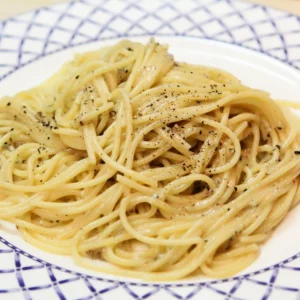
Cacio e Pepe Recipe: Simple, Quick, and Unforgettable!
Craving a pasta dish that’s a step up from your usual butter noodles? Cacio e pepe is here to elevate your meal! This Roman classic is deceptively simple but unbelievably delicious. “Cacio e pepe” means “cheese and pepper” in Italian, and that’s exactly what you’ll need—plus a few other essentials. Get ready for a burst of flavor!
Ingrédients
- 300 g of spaghetti e.g., De Cecco No. 12
- 200 g of pecorino romano finely grated
- 15 g of black pepper freshly ground
- 3 L of water
- 30 g of salt For the pasta water
Instructions
- Grate the pecorino romano finely and set it aside in a bowl.
- Place the pepper in a cold pan and toast over medium heat until fragrant. Remove from heat and reserve ¼ for garnish
- Boil 3 liters of salted water and cook the spaghetti until al dente (about 12 minutes). Do not add oil.
- Return ¾ of the toasted pepper to the pan over low heat. Add one ladle of pasta water.
- Gradually stir in the grated pecorino, mixing constantly. Add more pasta water as needed to create a creamy sauce.
- Drain the pasta (saving some cooking water) and toss it into the sauce. Mix thoroughly to coat.
- Plate the pasta on warm dishes, top with reserved pepper and pecorino, and optionally drizzle with olive oil.
Vidéo
Notes
FAQ: Cacio e Pepe
Can I use a different cheese than pecorino romano?Yes, parmesan is a common substitute, though it has a milder flavor. Can I make the sauce in advance?
No—it’s best to make the sauce just before serving so it doesn’t separate. How can I avoid clumps in the sauce?
Keep the heat low and stir constantly while adding cheese and water. Can I add other ingredients?
Traditionally, no—but feel free to customize with crispy pancetta or roasted veggies if you’d like. How do I store leftovers?
Cacio e pepe is best served fresh, but leftovers can be kept in the fridge for 24 hours. The sauce may separate, though.
Tips and Tricks for Cacio e Pepe Perfection
- Use top-quality ingredients, especially pecorino romano and fresh pepper.
- Toast the pepper in a cold pan for maximum flavor.
- Keep the heat low to avoid clumping when mixing the sauce.
- Toss quickly to coat the pasta while it’s still hot and moist.
- Serve immediately for the creamiest, tastiest experience.